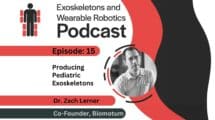In March of 2020, the team from TWIICE and EPFL shared a dramatic video of a powered lower-body exoskeleton used on the picturesque snow-covered mountain slopes of Europe (link: Powered Exoskeleton To Enable Individuals With SCI To Go Ski-Touring). TWIICE is now happy to announce that work on the project continues, and commercialization of the WIITE gait-assist exoskeleton for ski touring is planned for 2022.
The WIITE is an important development for exoskeleton perception. We tend to think of wearable robotic devices as complex machines that work best in controlled environments. A snow-covered mountain is hardly the environment one imagines for this technology. The striking imagery pushes the envelope on the potential applications for exoskeletons. While this is a positive development, there are still years of work ahead before this technology becomes universally accessible and that will happen only through hard work and investments.
“WIITE is a variant of the TWIICE exoskeleton, allowing a person with a complete spinal cord injury to stand up, walk, and most importantly, ski tour. Thanks to its compatibility with standard ski touring boots, it can be worn by the wearer and used in conjunction with mountaineering skis. It then allows its user, despite a complete motor and sensory disability, to practice ski touring.”
The development journey of WIITE would not be possible without the dedication of its test user, Martin Loos who has not gone ski-touring since his spinal cord injury a decade ago. While he is happy with his wheelchair, Martin yearned to be on the snow of the alps again. Even being at the cutting edge of exoskeleton technology some limitations remain. The user must have control and strength of their upper body to balance with crutches and an operator must be there to assist. The WIITE is suitable for ascents of slopes up to 40%, but not for descents. Battery life is limited to two hours of continuous use.
The TWIICE exoskeleton can be customized to each user to account for a limited range of motion or maximum movement speed amongst many other parameters. The control scheme requires manual input from embedded triggers in the crutch handles. Because this is an assistive, and not a rehabilitation exoskeleton, the intent of motion detection by the wearable device is traded for control and predictability. On the subject of predictable behavior, a smartwatch is utilized to display the status and fine-tune the exo on the fly.
The WIITE powered exoskeleton for ski touring is a technological partnership between motor manufacturer Sonceboz, based in the Bernese Jura, which supplies high-torque, compact electric motors. The components were developed in collaboration with the REHAssist group at EPFL and are used throughout the TWIICE family of powered exoskeletons. “The company Fischer Connectors, based in St-Prex and also sponsoring the project, has made available a custom-made version of the electrical connectors integrated in the exoskeleton.”
“More recently, the closing of a strategic partnership with Bâloise Insurance and the support of the Fondation Avenir Plus has given the project a new turn. The newly founded startup is determined to make this product accessible to people who need it. The commercialization is planned for 2022, with a new service model, allowing affordable technology through resource sharing.” This project shouldn’t be used as an example of how technology has already solved physical disability. Instead, it is the bold step forward on the journey of creating devices that are capable of compensating for lost functional capability.
Source: WIITE Press Release









Add Comment